NCERT Notes For Class 6 Maths Chapter 11 Algebra Introduction
Our study so far has been with numbers and shapes. We have learned numbers, operations on numbers, and properties of numbers. We applied our knowledge of numbers to various problems in our life.
The branch of mathematics in which we studied numbers is arithmetic. We have also learned about figures in two and three dimensions and their properties.
The branch of mathematics in which we studied shapes is geometry. Now we begin the study of another branch of mathematics. It is called algebra.
The main feature of the new branch which we are going to study is the use of letters. The use of letters will allow us to write rules and formulas in a general way. By using letters, we can talk about any number and not just a particular number.
Secondly, letters may stand for unknown quantities. By learning methods of determining unknowns, we develop powerful tools for solving puzzles and many problems from daily life.
Thirdly, since letters stand for numbers, operations can be performed on them as on numbers. This leads to the study of algebraic expressions and their properties.
You will find algebra interesting and useful. It is very useful in solving problems. Let us begin our study with simple examples.
Matchstick Patterns
Ameena and Sarita are making patterns with matchsticks. They decide to make simple patterns of the letters of the English alphabet. Ameena takes two matchsticks and forms the letter L as shown.

Then Sarita also picks two sticks, forms another letter L, and puts it next to the one made by Ameena.
Then Ameena adds one more L and this goes on as shown by the dots.
Their friend Appu comes in. He looks at the pattern. Appu always asks questions. He asks the girls, “How many matchsticks will be required to make seven Ls”?
Ameena and Sarita are systematic. They go on forming the patterns with 1L, 2Ls, 3Ls, and so on, and prepare a table.

Appu gets the answer to his question from the Table, 7Ls require 14 matchsticks.
While writing the table, Ameena realizes that the number of matchsticks required is twice the number of Ls formed.
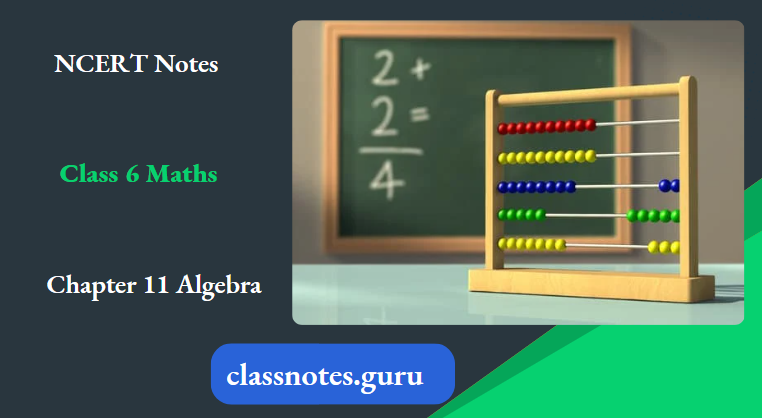
Number of matchsticks required = 2 x number of Ls.
For convenience, let us write the letter n for the number of Ls.
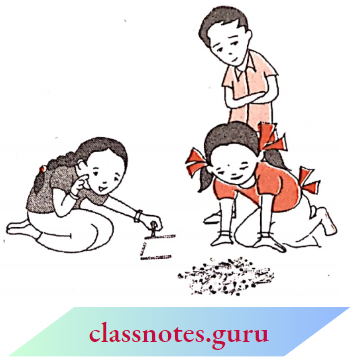
If one L is made, n = 1; if two Ls are made, n = 2, and so on; thus, n can be any natural number 1,2,3,4,5,….
We then write, Number of matchsticks required = 2 x n.
Instead of writing 2 x n, we write 2n.
Note that 2 n is the same as 2 x n.
Ameena tells her friends that her rule gives the number of matchsticks required for forming any number of Ls.
Thus, For n = 1, the number of matchsticks required = 2×1=2
For n = 2, the number of matchsticks required = 2×2 = 4
For = 3, the number of matchsticks required = 2×3 = 6, etc.
These numbers agree with those from Table.
Santa says, “Tito rule is very powerful! Using the rule, I can say how litany matchsticks are required to form even 100 Ls. I do not need to draw the pattern or make a table, once the rule is known”.
The Idea Of A Variable
In the above example, we found a rule to give the number of matchsticks required to make a pattern of Ls. The rule was:
Number of matchsticks required = 2n
Here, n is the number of Ls in the pattern, and n takes values 1, 2,3,4,…
Let us look at Table once again.
In the table, the value of n goes on changing (increasing). As a result, the number of matchsticks required also changed (increasing).
n is an example of a variable. Its value is not fixed; it can take any value 1, 2,3,4,… We wrote the rule for the number of matchsticks required using the variable n.
The word ‘variable’ means something that can vary, i.e. change. The value of a variable is not fixed. It can take different values.
We shall look at another example of matchstick patterns to learn more about variables.
NCERT Notes For Class 6 Maths More Matchstick Patterns
Ameena and Sarita have become quite interested in matchstick patterns. They now want to try a pattern of the letter C. To make one C, they use three matchsticks as shown.

The table gives the number of matchsticks required to make a pattern of Cs.

Santa conies up with the rule:
Number of matchsticks required = 3n
She has used the letter n for the number of Cs; is a variable taking on values 1, 2, 3,4,…
Do you agree with Sarita?
Remember 3n is the same as 3 x n.
Next, Ameena and Sarita wish to make a pattern of Fs.
They make one F using 4 matchsticks as shown.
Can you now write the rule for making patterns of F?
Think of other letters of the alphabet and other shapes that can be made from matchsticks. For example, U (U), V (V), triangle (A), square (□), etc.
More Examples Of Variables
We have used the letter n to show a variable. Raju asks, “Why not m”?
There is nothing special about n, any letter can be used.
One may use any letter, such as m, l, p, x, y, z, etc. to show a variable. Remember, a variable is a number which does not have a fixed value.
For example, the number 5 the number 100, or any other given number is not a variable.
They have fixed values. Similarly, the number of angles of a triangle has a fixed value i.e. 3. It is not a variable. The number of corners of a quadrilateral (4) is fixed; it is also not a variable.
But n in the examples we have looked at is a variable. It takes on various values 1,2,3,4,…
Let us now consider variables in a more familiar situation.
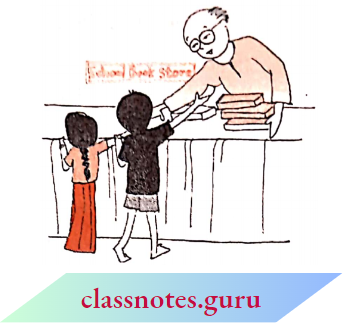
Students went to buy notebooks from the school bookstore. The price of one notebook is ₹5. Munnu wants to buy 5 notebooks, Appu wants to buy 7 notebooks, Sara wants to buy 4 notebooks, and so on.
How much money should a student carry when she or he goes to the bookstore to buy notebooks?
This will depend on how many notebooks the student wants to buy. The students work together to prepare a table.
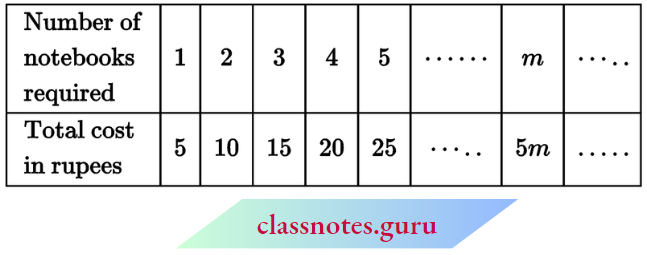
The letter m stands for the number of notebooks a student wants to buy; m is a variable, which can take any value 1, 2, 3, 4, …..
The total cost of m notebooks is given by the rule:
The total cost in rupees = 5 x number of notebooks required = 5m
If Munnu wants to buy 5 notebooks, then taking m = 5, we say that Munnu should carry ₹5 x 5 or ₹ 25 with him to the school bookstore.
Let us take one more example. For the Republic Day celebration in the school, children are going to perform mass drills in the presence of the chief guest. They stand 10 in a row. How many children can there be in the drill?
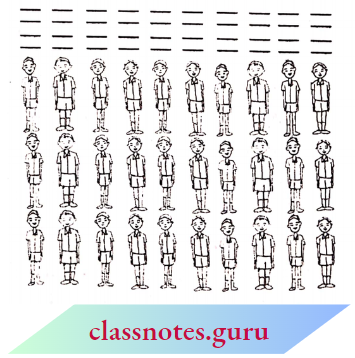
The number of children will depend on the number of rows. If there is 1 row, there will be 10 children. If there are 2 rows, there will be 2 x 10 or 20 children, and so on.
If there are r rows, there will be 1 Or children in the drill; here, r is a variable that stands for the number of rows and so takes on values 1,2,3,4…..
In all the examples seen so far, the variable was multiplied by a number. There can be different situations as well in which numbers are added to or subtracted from the variable as seen below.
Sarita says that she has 10 more marbles in her collection than Ameena. If Ameena has 20 marbles, then Sarita has 30. If Ameena has 30 marbles, then Sarita has 40, and so on.
We do not know exactly how many marbles Ameena has. She may have any number of marbles.
But we know that, Sarita’s marbles = Ameena’s marbles + 10.
We shall denote Ameena’s marbles by the letter x. Here, x is a variable, which can take any value 1, 2, 3, 4,…,10,…,20,…,30,…….
Using x, we write Sarita’s marbles = x + 10. The expression (x + 10) is read as ‘x plus ten’.
It means 10 added to x. If x is 20, (x + 10) is 30. If x is 30, (x + 10) is 40 and so on.
The expression (x + 10) cannot be simplified further.
Do not confuse x + 10 with 10x, they are different.
In 10x, x is multiplied by 10. In (x + 10), 10 is added to x. We may check this for some values of x.
For example,
If x = 2, 10x = 10 x 2 = 20 and x + 10 = 2 + 10 = 12.
If x= 10, 10x= 10 x 10= 100 and x + 10= 10+ 10 = 20.
Raju and Balu are brothers. Balu is younger than Raju by 3 years. When Raju is 12 years old, Balu is 9 years old. When Raju is 15 years old, Balu is 12 years old.

We do not know Raju’s age exactly. It may have any value. Let x denote Raju’s age in years, x is a variable.
If Raju’s age in years is x, then Balu’s age in years is (x – 3). The expression (x – 3) is read as x minus three. As you would expect, when x is 12, (x – 3) is 9, and when x is 15, (x – 3) is 12.
